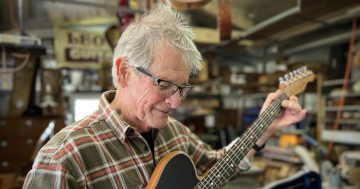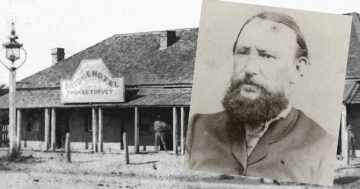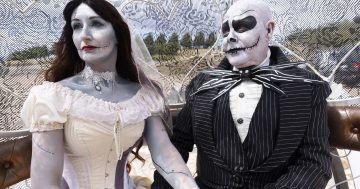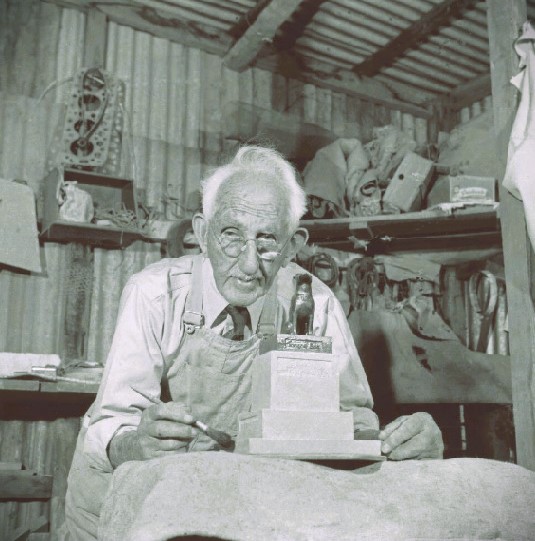
The sculptor Frank Rusconi with a model of the Dog on the Tuckerbox sculpture, Gundagai, circa 1950. Photo: Jeff Carter/National Library of Australia Catalogue.
We all know the Australian cultural treasure that is “The Dog on the Tuckerbox”, but did you know just down the road, in Gundagai, sits another masterpiece by the same stonemason with a splashy vibe?
While the better-known dog statue was inspired by the bullock drover’s poem, Bullocky Bill, celebrating the life of a mythical drover’s dog that loyally guarded the man’s tuckerbox until death, a marble table at Sydney’s Powerhouse Museum is said to have inspired Frank Rusconi’s greatest project.
The Gundagai Independent of Friday, 28 October, 1938, begs to differ; it says Rusconi’s inspiration was a cup and saucer.
But what sits today at Gundagai’s Visitor Information Centre – Rusconi’s Marble Masterpiece – is testament to one man’s determination that Australia could produce marble equal to the best of other countries.
And he would know.
Frank Rusconi would be a man of the world before, in 1905 aged 31, he settled in Gundagai having established a monumental masonry business.
But what he also brought to the small town was a gift and a legacy that endures.
Born in Araluen, near Braidwood, in 1874, Frank Rusconi was four when he returned to Europe with his family after his mother died and, at age 13, he was apprenticed to the marble trade in Italy and the famous Swiss-watchmaking town of Neuchatel in Switzerland.
He would subsequently work in England, France and Italy specialising in the interior and exterior decoration of buildings, which included Westminster Cathedral, Sacre Coeur Cathedral at Montmartre and the lavish “Oldway House” in Devonshire.
But Rusconi carried with him a small cup and saucer, fashioned from marble he’d found during a picnic at Borenore, near Orange, when he returned home to Australia briefly in 1895.
However, according to the aforementioned article in The Gundagai Independent, a disbelieving audience placed the marble as Belgian. Rusconi was all but called a liar.
Determined to prove the naysayers wrong and Australian marble a world-class product, Rusconi returned to Australia in 1901, travelling back to that picnic spot where he would establish his Borenore marble quarries near Orange, where he worked with his father and brother Joe.
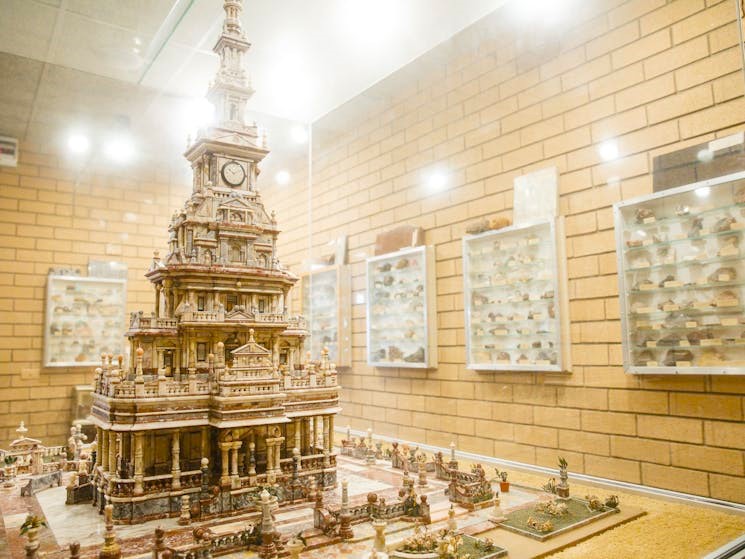
Twenty different types of marble collected throughout NSW were used to create Rusconi’s Marble Masterpiece. Photo: VisitNSW.
Borenore marble would become known for its rich red and blue colouration: the red was used in public buildings such as the Art Gallery of NSW, Sydney’s Central Railway Station and the opulent Commonwealth Bank in Martin Place, while the blue, containing fossilised corals, was ideal for ornaments and furnishings.
It was from both, though, that the marble table at the Powerhouse Museum was fashioned in situ by the Rusconis at the quarry.
The museum has several examples of blue and red Borenore marble in slab and column form, including a mantlepiece.
Frank Rusconi would settle at Gundagai in 1905, establishing a monumental-masonry business.
Four years later, in his spare time, he began his magnum opus.
Rusconi believed passionately in the as-yet unrealised potential of Australia’s building stones so, determined to showcase their diversity and beauty, set about collecting 20 different types of marble from all over NSW, including Borenore, Caleula (near Blayney), Mudgee, Bathurst, Galong, Gilmore (near Tumut), Kempsey, Gundagai and Rylstone.
Without any plans or drawings and aided by a treadle lathe constructed from an old sewing machine, he set about “making a clock” in his spare time.
It would take 28 years for Rusconi to complete his Marble Masterpiece – a cathedral in miniature – comprising 20,948 pieces of marble he collected, hand cut, turned and polished using ordinary stonemason’s implements.
The largest piece of marble is a 13-centimetre-tall column, while the smallest piece is just over 0.2 cm tall.
Rusconi would complete the various sections and put them away until the entire building was assembled.
The elaborately detailed 120 cm-high model of an imaginary Baroque Italian palace – complete with clock – is set in a formal square with fountains, garden seats, flower pots, flowers, a bird bath and dog’s water dish, and lamp posts – including electric fitting and globes.
In addition to the 20,948 pieces used, said The Gundagai Independent, 9011 pieces had to be discarded during construction, so the builder would have exact matches.
Frank Rusconi died in 1964 at the age of 90.
The Marble Masterpiece is displayed at the Gundagai Visitor Information Centre.
Original Article published by Edwina Mason on About Regional.







